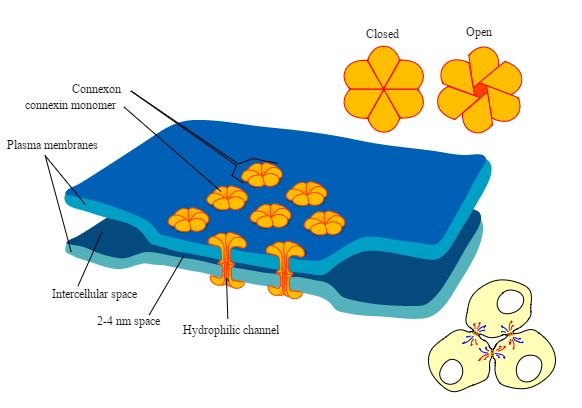10.5F: The Synapse
- Page ID
- 7595
A synapse is a structural junction that mediates information transfer from one neuron to the next or from one neuron to an effector cell as in muscle or gland.
- Describe the role of a synapse in nervous tissue
Key Points
- In the nervous system, a synapse is a structure that permits a neuron to pass an electrical or chemical signal to another cell.
- The neuron conducting impulses towards the synapse is called pre-synaptic neuron. The neuron transmitting the electrical impulse away from the synapse is called post-synaptic neuron, if the post-synaptic cell is not neuronal it is sometimes referred to as an effector cell.
- There are two varieties of synapses: electrical and chemical synapse based on the type of transmission.
- Chemical synapses rely on the secretion of neurotransmitters across a synaptic cleft between cells. Receptors on the post-synaptic cell bind these neurotransmitters and induce a signalling response.
- Electrical synapses form when the plasma membranes of two neurons are fused, and punctured by gap junction proteins, allowing for the diffusion of ions across the plasma cell membrane.
- Chemical synapses are slower than electrical synapses, but allow for gain, or amplification of signal.
Key Terms
- axon: A long, slender projection of a nerve cell, or neuron, that typically conducts electrical impulses away from the neuron’s cell body.
- synapse: A structure that permits a neuron to pass an electrical or chemical signal to another cell.
In the nervous system, a synapse is a structure that permits the axon of a neuron to pass an electrical or chemical signal the axon of another neuron or to another cell type.
The neuron conducting impulses towards the synapse is called pre-synaptic neuron. The neuron transmitting the electrical impulse away from the synapse is called post-synaptic neuron, if the post-synaptic cell is not neuronal it is sometimes referred to as an effector cell.
Synapses can be classified by the type of cellular structures serving as the pre- and post-synaptic components. The vast majority of synapses in the mammalian nervous system are axo-axonal (axon synapsing with another axon) or axo-dendritic synapses (axon synapsing upon a dendrite). However, a variety of other arrangements exist.
Chemical and Electrical Synapses
Chemical Synapse: A: Pre-synaptic neuron B: Post-synaptic-neuron. Neurotransmitters are stored in synaptic vesicles within the pre-synaptic neuron (2). Upon receipt of an action-potential the neurotransmitter is secreted into the synaptic cleft (3 & 4) and binds to the receptors on the post-synaptic neuron (5).
There are two varieties of synapses: electrical and chemical synapse.
In a chemical synapse, the plasma membrane of the pre-synaptic neuron is closely associated with the plasma membrane of the post-synaptic cell, with the gap between termed the synaptic cleft. The synapse is stabilized by the expression of synaptic adhesion molecules projecting from both the pre- and post-synaptic cells maintaining the close association.
Upon arrival of an action potential at the pre-synaptic axon neurotransmitters are released into the synaptic cleft via the action of voltage-gated calcium channels. This neurotransmitter binds to receptors located in the plasma membrane of the post-synaptic cell which can elicit an electrical response or the activation of a secondary messenger pathway. Because of the complexity of receptor signal transduction, chemical synapses can have complex effects on the post-synaptic cell, and are able to induce effects such as gain, or amplification, whereby the strength of the signal is increased in the post-synaptic cell.
In an electrical synapse, the pre-synaptic and post-synaptic cell membranes are fused and connected by special channels called gap junctions that are capable of passing electrical current. These gap junctions contain connexion proteins which allow ions and small molecules to flow directly from one neuron to the next. The neurons are electrically coupled and transmission across these synapses is very rapid, allowing for faster signal processing than chemical synapses. However, due to their nature electical synapses cannot induce gain of signal strength.

Electrical Synapse: The membranes of pre and post-synaptic cells are fused and punctured by gap-junctions. When open they allow the rapid diffusion of ions across the plasma membranes allowing for rapid, continuous signal processing across the synapse.

